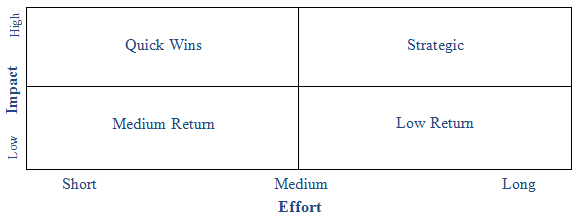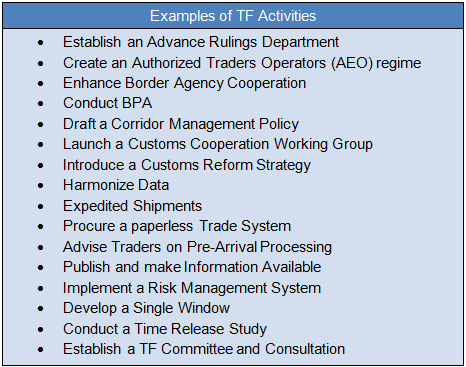Optional. This page shows how to formulate the Activities required to achieve a specific Goal
Activities
Under this chapter, the Roadmap needs to define what Activities will be required to achieve a specific Goal. In the context of the Roadmap, an Activity is a specific project that will undertake a specific action or reform or will implement a trade facilitation instrument or solution.
An Activity can be, for example:
“Activity 1: Introduce an electronic payment system for importers and exporters at Customs clearance points.”
“Activity 2: Conduct a Business Process Analysis on the procedures and documents required for key national export products.”
A non-comprehensive list of possible Roadmap Activities is provided in the figure below:
As a Roadmap is usually implemented over a three to five-year period, the description of Activities should be kept broad and just describe what the Activity is and not which methodologies or approaches will be used to put in place the Activity. The description of how the Activity is implemented will be described in the project plans that will be developed during the implementation of the Roadmap. Thus, establishing detailed project plans for the implementation of the Activities can be considered a first Activity of the Roadmap itself.
Identifying activity compliance indicators
Activity Compliance Indicators (ACI) measure whether an Activity has been successfully implemented in terms of quantity, quality, time frame and location.
As explained before, a same Goal Performance Indicator can be used to measure the achievement of more than one Activity. However, an Activity Compliance Indicator remains specific to a particular Activity.
Prioritization of activities
When drafting the Roadmap, Activities should be scheduled according to prioritization and interdependency. Interdependency means that some measures can only be achieved after others have already been implemented. For instance, in order to establish an Authorized Economic Operator Scheme, a risk management system should already be in place to identify the compliant traders that can participate in the AEO Scheme.
Prioritization is a process to evaluate the effort needed to implement an Activity and the impact it will have on the Goals compared to other Activities. Activities that are easy to implement and have a big impact should have a higher priority than those that are difficult to implement and only bring little improvements. Therefore, as the Activities are identified, each needs to be assessed and attributed with a level of effort and a return on investment.
The following techniques are suggested to help the Drafting Team to prioritize Activities.
Firstly, the Drafting Team categorizes the Activities into three groups, as follows:
- Quick wins: Activities that can generate a significant impact yet require a relatively small effort to implement. For example, simply removing an unnecessary procedure that is blocking or delaying the flow of goods through a port can have a major impact on throughput.
- Medium Return Activities that require low to moderate effort that have low to moderate impact. Could be considered as 2nd level activities.
- Strategic: Activities that require higher effort and can be realized in the long term. They usually will have a high impact on Goals.
- Low Return: Activities that require a lot of effort and have low impact. Could be considered if strategically important but otherwise may be left out.
The following graphic shows an example of how Activities can be visually represented for prioritization:

The Drafting Team can present the final graphic to the stakeholders for discussion and final discussion and approval. After prioritization, the Activities should be summarized in an Activity plan that will indicate the leading agency, timeline, budget, and compliance indicators for each specific Activity.

